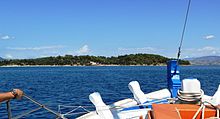Vido
| Vido (Βίδο) | ||
|---|---|---|
| Vido (right) in front of the east coast of Corfu | ||
| Waters | Ionian sea | |
| Archipelago | Ionian islands | |
| Geographical location | 39 ° 38 '27 " N , 19 ° 55' 32" E | |
|
|
||
| length | 1 km | |
| width | 600 m | |
| surface | 53 ha | |
| Residents | uninhabited | |
| Vido | ||
Vido ( Greek Βίδο [ viðɔ ], actually to Nisi tou Bido το Νήσι του Βίδο, the island of Guido ', older names Ptychia ( ancient Greek Πτυχία ) Ireou Nisus Ηραίου Νήσος, Agios Stefanos Άγιος Στέφανος or Nisi tis Irinis Νησί της Ειρήνης Island des Friedens') is a small island off the town of Corfu , around 1.2 km north of the old port. Today it mainly serves as the local recreation area of the island's capital and is a destination for Corfu tourists.
The ancient name Ptychia has been passed down from Thucydides , Pliny the Elder and Stephanos of Byzantium , among others . Thucydides identified the island with the location of a temple of Hera (hence the name Ireou Nisos 'island of the temple of Hera'), on which the Athenian general Eurymedon arrested the oligarchs of the island during the Peloponnesian War after the victory over the Corfiots, in order to bring them unharmed to Athens ships, but surrendered to the island's population on the basis of a ruse by their Corfiot opponents who persuaded them to flee.
Around the year 80 the island became the starting point for the Christianization of Corfu: Two missionaries, Saints Jason and Sosipatros, are said to have built the first church of Corfu, consecrated to Saint Stephen , and to have Christianized Corfu from there. The archon of Corfu, Kerkillinos , is said to have persecuted and captured them, and the prison guard Antonios, who was converted by them and who subsequently suffered martyrdom and was buried in the church, is considered to be Corfu's first martyr. After this church of St. Stephen, the island was named Agios Stefanos until the Middle Ages .
Under Venetian rule a Theodoros Skalitis was enfeoffed with the island, after whose death it came into the possession of the Venetian nobleman Pietro Malipiero and later of his son Guido, from whom the island's current name comes from. The Pierri-Chalkiopoulou family later became the owners of the island, which at that time enabled a good income with wine and olive growing.
The Ottoman Empire used the island in its attempts to conquer Corfu as a base for the unsuccessful bombing of the city. Nevertheless, the Venetians did not consider the island to be of any major strategic importance. It was not until Johann Matthias von der Schulenburg made plans to fortify the island, which were tackled in 1727, but which did not go beyond a small fortress in the northwest of the island, which was later named Ochyro Schoulembourg ('Schulenburg Fortress') received.
Only after the conquest of Corfu in 1797 did the Napoleonic army begin to systematically expand the island into a base for 450 soldiers, with the old St. Stephen's Church being destroyed. However, the Russian intervention in Corfu prevented the completion of these plans as well. The hotly contested island of Vido played a key role in the conquest of Corfu by the Russian Navy. Its conquest on February 18, 1799 broke the resistance of the French, who suffered great losses and soon afterwards withdrew from Corfu. After their return to Corfu in 1807, the French military began renovating the Schulenburg fortress and building three large fortifications on the island. Without any further acts of war, Corfu fell under British rule in 1814, which led to the complete rebuilding of the fortifications in line with the latest military architecture. The British also examined the ruins of the old St. Stephen's Church and found an old mosaic and remains of an older previous building of the church.
With the annexation of the Republic of the Ionian Islands to the Greek state, the demilitarization of the island was contractually linked: in 1864 the weapons were brought from the island and the military facilities razed. The island was a ruined landscape of former fortresses, but some stables have been preserved and are now used as a restaurant. In 1898 an agricultural station was established again on the island, and in 1912 three business people began to develop the island as a recreational area with bathing facilities.
In 1916 the island became a site of the First World War: 130,000 Serbian soldiers fled from the Austrians and found shelter between the ruins of the English fortresses on Vido. Diseases reduced their number by about 30,000. In 1936 a mausoleum was built as a memorial to commemorate the Serbs who died here.
In 1918 a prison was set up on the island, and in 1929 work began on building a new church over the walls of the old Stefanskirche, which was again destroyed by German troops in 1944.
The municipality of Corfu has been responsible for the island since 1985. In addition to the reconstruction of the church and the establishment of tourist infrastructure, which supplies the two beaches on the island, the island, which has now again been covered with trees, has been expanded into a local recreation area.
Web links
- Portrait of the island on the sides of the municipality of Corfu (Greek)
- Brief information about the island






